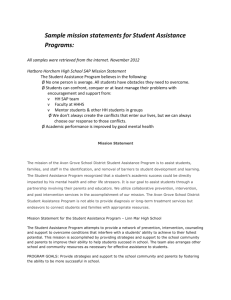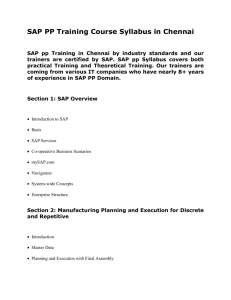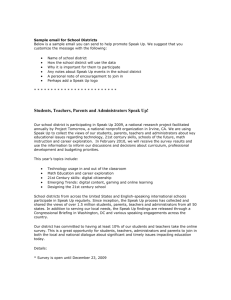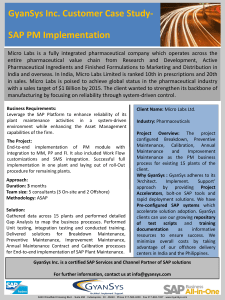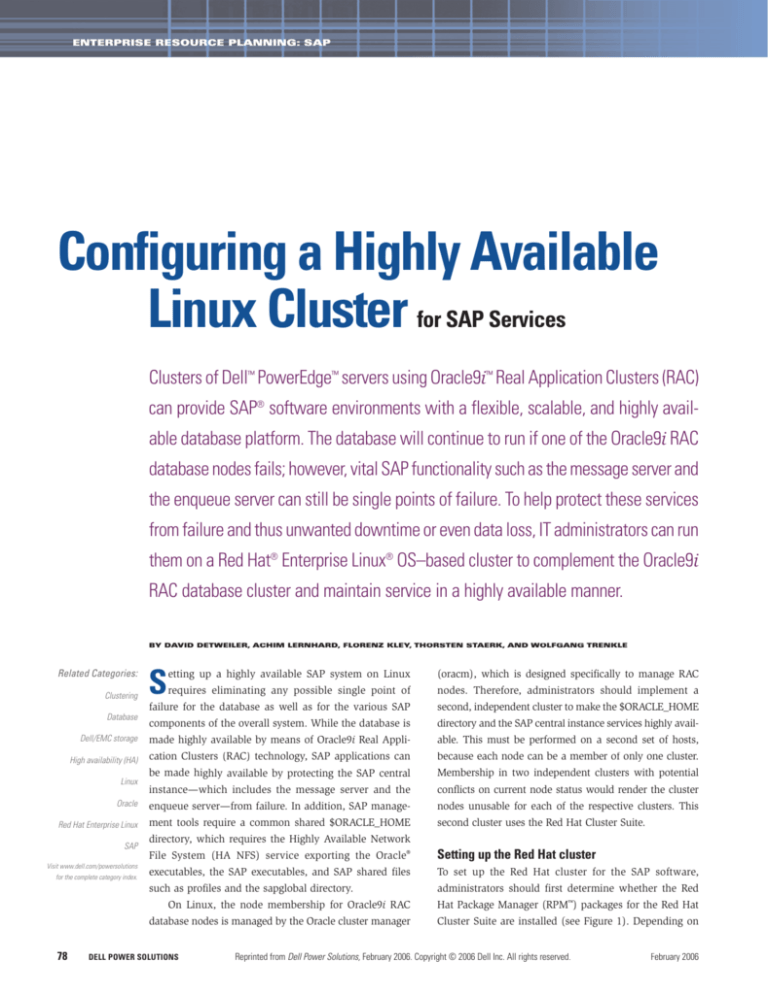
ENTERPRISE RESOURCE PLANNING: SAP
Configuring a Highly Available
Linux Cluster for SAP Services
Clusters of Dell™ PowerEdge™ servers using Oracle9i™ Real Application Clusters (RAC)
can provide SAP® software environments with a flexible, scalable, and highly available database platform. The database will continue to run if one of the Oracle9i RAC
database nodes fails; however, vital SAP functionality such as the message server and
the enqueue server can still be single points of failure. To help protect these services
from failure and thus unwanted downtime or even data loss, IT administrators can run
them on a Red Hat® Enterprise Linux® OS–based cluster to complement the Oracle9i
RAC database cluster and maintain service in a highly available manner.
BY DAVID DETWEILER, ACHIM LERNHARD, FLORENZ KLEY, THORSTEN STAERK, AND WOLFGANG TRENKLE
Related Categories:
Clustering
Database
S
etting up a highly available SAP system on Linux
(oracm), which is designed specifically to manage RAC
requires eliminating any possible single point of
nodes. Therefore, administrators should implement a
failure for the database as well as for the various SAP
second, independent cluster to make the $ORACLE_HOME
components of the overall system. While the database is
directory and the SAP central instance services highly avail-
Dell/EMC storage
made highly available by means of Oracle9i Real Appli-
able. This must be performed on a second set of hosts,
High availability (HA)
cation Clusters (RAC) technology, SAP applications can
because each node can be a member of only one cluster.
be made highly available by protecting the SAP central
Membership in two independent clusters with potential
Linux
instance—which includes the message server and the
conflicts on current node status would render the cluster
Oracle
enqueue server—from failure. In addition, SAP manage-
nodes unusable for each of the respective clusters. This
Red Hat Enterprise Linux
ment tools require a common shared $ORACLE_HOME
second cluster uses the Red Hat Cluster Suite.
SAP
Visit www.dell.com/powersolutions
for the complete category index.
78
directory, which requires the Highly Available Network
File System (HA NFS) service exporting the Oracle®
Setting up the Red Hat cluster
executables, the SAP executables, and SAP shared files
To set up the Red Hat cluster for the SAP software,
such as profiles and the sapglobal directory.
administrators should first determine whether the Red
On Linux, the node membership for Oracle9i RAC
Hat Package Manager (RPM™) packages for the Red Hat
database nodes is managed by the Oracle cluster manager
Cluster Suite are installed (see Figure 1). Depending on
DELL POWER SOLUTIONS
Reprinted from Dell Power Solutions, February 2006. Copyright © 2006 Dell Inc. All rights reserved.
February 2006
ENTERPRISE RESOURCE PLANNING: SAP
Configuring the shared storage
[root@ls3220 root]# rpm -q clumanager
clumanager-1.2.16-1
After testing the network connections, administrators can set up the
shared storage. The cluster software needs two small partitions as
[root@ls3220 root]# rpm -q redhat-config-cluster
redhat-config-cluster-1.0.2-2.0
quorum devices, which should be configured on separate logical units
(LUNs) to maximize independence and minimize possible contention.
The partitions must have a minimum size of 10 MB each. However,
the usual minimum size for a LUN on a Dell/EMC storage array is
Figure 1. Checking for Red Hat Cluster Suite RPM packages
100 MB. The quorum LUNs will be bound later as raw devices.
the availability of updates, the version numbers may differ. Admin-
to hold the file systems for the data to be exported via the HA
istrators should install the most recent version of these packages.
NFS server. They should follow Oracle recommendations regard-
They should then prepare the shared storage and the network con-
ing the size for $ORACLE_HOME and SAP recommendations for
nections. Throughout the example scenario used in this article, the
the executables (approximately 300 to 400 MB depending on the
server names ls3219 and ls3220 are used for the first and second
kernel version), and they should take into account the data that
cluster nodes, respectively.
will be stored in the LUNs as well. Once the LUNs have been
Additionally, administrators should create one or more LUNs
created on the storage system, administrators can make them
Configuring the network
available to the nodes.
Both nodes must have two available Ethernet interfaces. One
The next step is to create partitions on the quorum and NFS stor-
interface is used for cluster communication between the two
age LUNs. For the quorum LUN, one partition is enough. Because
nodes and should be on a private network. The other is the
administrators will bind these partitions as raw devices, they can set
publicly visible network interface. The private network interfaces
the partition type to “da” (non-file-system data) with the t option off
in this example are named dell3219 and dell3220, respectively.
fdisk. Figure 3 shows what the quorum partitions would look like
Depending on the specific requirements of the environment,
on the host in the example scenario. Administrators should create
administrators may want to set up four interfaces—two for each
and format partitions on the LUNs for the NFS directories.
node—using the Linux kernel bonding mechanism. This provides
Next, administrators should create persistent symbolic names
a highly available network connection on each channel and
for the partitions with devlabel. This program makes the partition
secures the cluster against failure of one single component (net-
device names resilient against device name reordering (for example,
work interface card, network cabling, or switch) on the respective
when the SCSI scan order is different). In the example scenario, the
communication channel.
persistent symbolic name /dev/homedir is created for the partition
Administrators should reserve one public IP address for each
used for the NFS export.
node. In this example scenario, these addresses are 10.17.64.25 for
Because the quorum disks are raw devices, they must be bound
node ls3219 and 10.17.64.26 for node ls3220. Administrators should
so as to be available to the kernel. When the special symbolic name
also reserve one private IP address for each node. For dell3219, the
/dev/raw/rawn
n is used with devlabel, the link is created and the
private address is 172.16.42.34; for dell3220, the private address
partition is bound as a raw device. Note that the identifier changes
is 172.16.42.35.
Additionally, administrators should reserve three IP addresses
for the cluster services to be used as virtual IP addresses. They
[root@ls3219 root]# cat /etc/sysconfig/
network-scripts/ifcfg-eth0
should configure the interfaces (or virtual interfaces) with these
DEVICE=eth0
addresses, either by using the redhat-config-network program
BOOTPROTO=static
or editing the respective interface setup files in /etc/sysconfig/
IPADDR=10.17.64.25
network-scripts. Figure 2 shows what the public interface on ls3219
NETMASK=255.255.252.0
should look like.
ONBOOT=yes
Administrators should set up all the interfaces on the nodes
according to the host names and IP addresses. This is the same
TYPE=Ethernet
GATEWAY=10.17.64.1
setup principle that is used in the Oracle9i RAC cluster: one public
and one private IP address per node.1
Figure 2. Example public interface setup file for node ls3219
1 For more information, refer to the “Checking the network connections” section in “Creating Flexible, Highly Available SAP Solutions Leveraging Oracle9i
and Linux on Dell Servers and Dell/EMC Storage” by David Detweiler,
Achim Lernhard, Florenz Kley, Thorsten Staerk, and Wolfgang Trenkle in Dell Power Solutions,
s November 2005; www.dell.com/downloads/global/power/ps4q05-20050174-SAP.pdf.
www.dell.com/powersolutions
Reprinted from Dell Power Solutions, February 2006. Copyright © 2006 Dell Inc. All rights reserved.
DELL POWER SOLUTIONS
79
ENTERPRISE RESOURCE PLANNING: SAP
Disk /dev/sdb: 314 MB, 314572800 bytes
[root@ls3220 root]# devlabel status
64 heads, 32 sectors/track, 300 cylinders
brw-rw----
Units = cylinders of 2048 * 512 = 1048576 bytes
brw-rw---Device Boot
Start
End
Blocks
Id
System
1
300
307184
da
Non-FS data
/dev/sdb1
root
disk
/dev/raw/raw1
--[RAW]--> /dev/sdb1
root
disk
/dev/raw/raw2
--[RAW]--> /dev/sdc1
brw-rw----
root
disk
/dev/homedir ->
/dev/sdd1
Disk /dev/sdc: 314 MB, 314572800 bytes
64 heads, 32 sectors/track, 300 cylinders
Units = cylinders of 2048 * 512 = 1048576 bytes
Figure 4. Checking the status of partitions
Device Boot
Start
End
Blocks
Id
System
example scenario). They should then repeat this step for the other
1
300
307184
da
Non-FS data
cluster member (ls3220). They can leave “Enable SW Watchdog”
/dev/sdc1
checked—this enables the software watchdog timer, which allows
a cluster member to reboot itself if the system hangs.
Next, administrators can name the NFS service by clicking
Figure 3. Example quorum partitions on host
the Services tab and then the New button to display the Service
to “RAW.” Administrators can check the result with the devlabel
dialog box. They should provide a name without spaces or spe-
status command (see Figure 4).
cial characters (this simplifies querying the status from the com-
Administrators can check whether the raw devices are bound.
mand line). In the example scenario, the HA NFS service name is
As shown in Figure 5, the raw command displays the major and
RAC_NFS_directories. Neither a failover domain nor a user script
minor numbers of the bound devices. Administrators can check
should be assigned. Administrators can click the OK button and go
these numbers against the currently assigned block devices (from
to File>Save to save the changes to the cluster configuration.
devlabel status).
In the next step, administrators can add a device to mount, a
Once the devlabel settings have been finalized, administrators
service IP address, and NFS clients to the service. In the example
can copy the /etc/sysconfig/devlabel file to the same directory
scenario, 10.17.64.27 is used as the IP address for the HA NFS ser-
on the other host. Then, they can log in to that host and issue
vice. To specify a service IP address, administrators should click the
the devlabel restart command. Administrators should not try
Services tab of the Cluster Configuration Tool. Then they can select
to add raw devices and symbolic names themselves; they should
the service and click the Add Child button. Next, administrators
allow devlabel sort out the unique IDs collected on the other node
select “Add Service IP Address” in the popup window and specify
to ensure that the same physical device is bound under the same
an IP address with netmask and broadcast in the next window.
symbolic name.
Although the netmask and broadcast addresses are optional, best
practices recommend setting them.
Configuring a clustered NFS service
Once the network and devices are configured, administrators can
[root@ls3220 root]# raw -qa
activate the Red Hat cluster. Logged in as the root user, administrators
/dev/raw/raw1:
bound to major 8, minor 17
can check whether the cluster services are running (see Figure 6).
/dev/raw/raw2:
bound to major 8, minor 33
If the output does not show that the cluster services have stopped,
administrators should stop them by issuing the stop argument to
the init-script. Then, they can start the redhat-config-cluster program,
Figure 5. Checking whether raw devices are bound
preferably in a Virtual Network Computing (VNC) session.
Administrators should begin by setting up the raw devices for
the cluster quorum. In the Cluster Configuration Tool, administrators should go to Cluster>Shared State to display the Shared State
[root@ls3220 root]# /etc/init.d/clumanager status
clumembd is stopped
cluquorumd is stopped
dialog box. In this box, administrators should enter the names of
clulockd is stopped
the two raw devices: /dev/raw/raw1 and /dev/raw/raw2.
clusvcmgrd is stopped
They should then add the two nodes as members of the cluster
by clicking the Members tab and going to File>New. In the dialog
box, administrators should enter the name of the host (ls3219 in this
80
DELL POWER SOLUTIONS
Figure 6. Checking whether cluster services are running
Reprinted from Dell Power Solutions, February 2006. Copyright © 2006 Dell Inc. All rights reserved.
February 2006
ENTERPRISE RESOURCE PLANNING: SAP
ORACLE CLUSTER FILE SYSTEM
A cluster file system allows all nodes in a cluster to concurrently
access a device via the standard file system interface—enabling
easy management of applications that need to run across a cluster. Oracle Cluster File System (OCFS) Release 1 was introduced in
December 2002 to enable Oracle RAC users to run the clustered
database without having to use raw devices. This file system
was designed to store database-related files such as data files,
control files, redo logs, and archive logs.
OCFS2—the next generation of the Oracle Cluster File
System—was introduced in August 2005 for Red Hat Enterprise
Linux 4 and Novell® SUSE™ Linux Enterprise Server 9 platforms.
This high-performance, general-purpose cluster file system can
store not only database-related files on a shared disk, but also
Oracle binaries and configuration files (shared Oracle home)—
helping to make the management of Oracle RAC easier using
OCFS2 than OCFS1. Also, any non-Oracle binaries or non-Oracle
configuration files, such as shared SAP directories, can be stored
on shared disks.
In addition, OCFS2 provides metadata caching; metadata
journaling; cross-node file data consistency; easy administration,
including operation as a shared root file system; support for
multiple block sizes; support for up to 254 cluster nodes; contextdependent symbolic link (CDSL) support for node-specific local
files; asynchronous and direct I/O support for database files for
improved database performance; and full integration with Linux
kernel 2.6 and later. With the release of OCFS2 on Linux, enterprises can implement Oracle RAC with these capabilities while
enhancing the overall environment by not having to use HA NFS
Linux volumes for the required shared SAP directories.
Administrators should choose a file system type from the FS Type
list (ext3 is used in the example scenario).
Administrators can specify options for the device. If the Options
field is left blank, the default mount options (rw, suid, dev, exec,
auto, nouser, and async) are used.2 Administrators can check “Force
Unmount” to force any application that has the specified file system
mounted to be shut down prior to disabling or relocating the service (when the application is running on the same cluster member
that is running the disabled or relocated service). When finished,
administrators can click the OK button and go to File>Save to
save the changes to the /etc/cluster.xml configuration file, and go
to File>Quit to exit the Cluster Configuration Tool.
Testing the cluster
Once the cluster is configured, administrators can begin the first cluster test. First, administrators should restart the redhat-config-cluster
program and go to Cluster>Start local cluster daemons. Once the
status display shows that the host has changed from “Unknown” to
“Active,” administrators can enable the service by selecting it in the
Services window and clicking “Enable.” The service status should
change from “Disabled” (red) to “Running” (black). On this node,
administrators should now see the mounted device under the configured mount point. If administrators do not see the device, they should
check the system log for cluster service error messages.
After a successful test on one node, administrators can copy the
/etc/cluster.xml file into the same directory on the other node. Then,
they can start the cluster services there, either with the init script
or with the redhat-config-cluster graphical user interface (GUI).
Administrators also should test switching the service between the
two cluster hosts.
Adding clients to the clustered NFS service
After testing that the cluster runs properly, administrators should
extend the configuration of the NFS service to export one or more
directories to the clients. Administrators should check that the NFS
daemon and the portmapper run on both hosts and are configured
To add the device to be mounted by the service, administrators
can click the Services tab of the Cluster Configuration Tool, select
to start automatically. They should execute the following commands
on both hosts:
the service, and click the Add Child button. They can then select
“Add Device” and click the OK button. Then they can specify a
/sbin/chkconfig --level 345 nfs on
device special file (in this example, /dev/homedir) and a mount
/sbin/chkconfig --level 345 portmap on
point (/sapmnt/clu_export). Each device must have a unique device
special file and a unique mount point within the cluster and across
This enables automatic starting in the runlevels 3, 4, and
service boundaries. Administrators can specify a directory from
5. Administrators can check the result by entering the following
which to mount the device in the Mount Point field. This directory
command:
cannot be listed in /etc/fstab because it is automatically mounted
by the Red Hat Cluster Manager when the service is started.
/sbin/chkconfig –list service
2 For a description of the available options, administrators should refer to the mount man page.
82
DELL POWER SOLUTIONS
Reprinted from Dell Power Solutions, February 2006. Copyright © 2006 Dell Inc. All rights reserved.
February 2006
ENTERPRISE RESOURCE PLANNING: SAP
Service RAC_NFS_directories
The output should look similar to the following:
[root@ls3220 root]# /sbin/chkconfig --list nfs
nfs
0:off
5:on
1:off
2:on
3:on
4:on
6:off
In addition, the output should look similar for services that
will be set up later. Administrators should perform these steps on
both hosts.
service_ipaddress
ipaddress=”172.16.42.60”
netmask=”255.255.255.0”
broadcast=”172.16.42.255”
device name=”/dev/homedir”
mountpoint=”/sapmnt/clu_export”
fstype=”ext3”
forceunmount=”yes”
Next, administrators should return to the cluster configuration GUI and click the Services tab. They should select the NFS
service and click the collapse/expand indicator, or twistie,
e on the
left to display the contents. Administrators should see the service
IP address and the service device. They can then select the device
and click the Add Child button. A popup window asks for the
export directory name. In this example scenario, everything below
nfsexport name=”/sapmnt/clu_export/readonly”
client name=”172.16.42.0/24”
options=”ro,async”
nfsexport name=”/sapmnt/clu_export/readwrite”
client name=”172.16.42.0/24”
options=”rw,sync”
/sapmnt/clu_export is exported, and the following directories are
nfsexport name=”/sapmnt/clu_export/readwrite_root”
client name=”172.16.42.0/24”
options=”rw,sync,no_root_squash”
exported with different access permissions:
•
/sapmnt/clu_export/readonly (ro, async)
•
/sapmnt/clu_export/read_write (rw, sync)
•
/sapmnt/clu_export/read_write_root (rw, sync, no_root_squash)
Figure 7. NFS service directory structure
Even when it is not immediately necessary to create an export
directory mounts directories exported by hostname. All clients
that is root-writeable and preserves the user ID (without reassign-
mount the exported directories there. The /etc/fstab entries for the
ing nfsnobody to root), best practices recommend configuring the
example scenario are shown in Figure 8.
export with these settings—to enable backups and quick file dis-
Adapting the SAP directory structure
tribution among the hosts.
The allowed client and permissions are attributes of the
Locally, symbolic links point to the NFS-mounted directories. For
NFS Export Client object, which is a child of the NFS Export
example, the SAP instance DVBGS00 would expect the directory
object. Administrators can add the clients again by selecting “NFS
structure shown in Figure 9 on its server. The directories are
Export” and clicking the Add Child button. When finished, the
located on NFS and can be found in the same location (that is, with
NFS service structure should resemble the structure of the XML
the identical pathname) on every host. The /usr/sap/RAC/SYS
file /etc/cluster.xml (see Figure 7).
directory links to /sapmnt/RAC (see Figure 10), and the /sapmnt/
Note: The NFS export is under the control of the Red Hat cluster,
and the directories exported there must not appear in the /etc/
exports file used by the non-clustered NFS daemon.
RAC directory links to the NFS directories (see Figure 11).
In the example scenario, the NFS directories are organized
by system ID (SID) to support more than one SAP system (see
Figure 12). The readonly/ and readwrite/ incarnations of the
Client-side mount options
RAC_sapsystem directory show that the directories used by
On the client side, the directories are mounted under /sapmnt/
an SAP system are divided by these attributes, as shown in
homedir/readonly following a schema where /sapmnt/hostname/
Figure 13.
# HA NFS exports
homedir:/sapmnt/clu_export/readonly
homedir:/sapmnt/clu_export/readwrite
homedir:/sapmnt/clu_export/readwrite_root
/sapmnt/homedir/readonly
/sapmnt/homedir/readwrite
/sapmnt/homedir/readwrite_root
nfs\ hard,intr,nolock,ro,bg
nfs\ hard,intr,sync,bg
nfs\ hard,intr,sync,bg
0 0
0 0
0 0
Figure 8. Example /etc/fstab entries
www.dell.com/powersolutions
Reprinted from Dell Power Solutions, February 2006. Copyright © 2006 Dell Inc. All rights reserved.
DELL POWER SOLUTIONS
83
ENTERPRISE RESOURCE PLANNING: SAP
The SAP solution to the enqueue challenge is the stand-alone
ls3220:racadm-DVBGS00 > find /usr/sap/RAC/
DVBGS00/* -prune
/usr/sap/RAC/DVBGS00/data
/usr/sap/RAC/DVBGS00/log
/usr/sap/RAC/DVBGS00/sec
/usr/sap/RAC/DVBGS00/work
enqueue server and the enqueue replication mechanism. With these
components, the enqueue server runs as a stand-alone program
and can be contacted directly by enqueue clients. Additionally, a
second enqueue server—called the enqueue replication server—is
started; its only task is to maintain a second copy of the enqueue
state table (lock table). Communicating regularly with the enqueue
server, the enqueue replication server keeps its copy of the enqueue
table current. If the enqueue server fails, it can be restarted on the
Figure 9. Directory structure for DVBGS00 SAP instance
host where the enqueue replication server runs. When the enqueue
Configuring SAP central instance services for the cluster
replication server recognizes that the enqueue server has started
Access to data in the underlying database of an SAP system is
up, it will transfer its current lock table before exiting. The newly
synchronized with a special lock system called the SAP enqueue
started enqueue server can now continue without losing valuable
mechanism. This mechanism serializes access and prevents access
enqueue state information. Additionally, OS-level high-availability
from being changed for more than one requesting party.
software makes the enqueue server available via a virtual, clustered
The enqueue server usually runs as a service of the SAP central instance. If clients run in the same SAP instance, they can
IP address, masking the restart from the clients so that they always
connect to the same IP address.
contact the enqueue server via the UNIX® Interprocess Communication (IPC) mechanism; if they are not part of the central instance,
Splitting the central instance
clients contact the enqueue server via the SAP message server. As
To secure the SAP system’s services in a high-availability cluster,
opposed to all other components of the SAP system on the application
administrators must split the traditional central instance into dedi-
layer, the enqueue server holds a state—an in-memory table of granted
cated instances because a large “service block” can be difficult to
locks—that cannot be recovered gracefully if the service fails. The
monitor. Furthermore, this large block makes restarting services
message server, which consequently plays an important role in con-
difficult, because administrators must also restart parts of the central
tacting the enqueue server, holds no state; it receives only incoming
instance that have not failed.
connection requests and transfers them to the addressee. The mes-
To run the enqueue server as a master/slave service, the
sage server can be restarted after failure, with no impact other
enqueue service and the enqueue replication service should always
than delayed communications. The enqueue server is a poten-
reside on different hosts. The message server is not bound to a
tial single point of failure in an SAP system, isolated from the
particular host. Because these are the two services that consti-
failover provided at the database layer.
tute a central instance, the cluster can run only those services,
ls3220:racadm-DVBGS00 > ls -l /usr/sap/RAC/SYS/
total 4
drwxr-xr-x
2 racadm
sapsys 4096 Nov 11 12:44 exe
lrwxrwxrwx
1 racadm
sapsys
18 Jan 24 14:48 global -> /sapmnt/RAC/global
lrwxrwxrwx
1 racadm
sapsys
19 Jan 24 14:49 profile -> /sapmnt/RAC/profile
Figure 10. Links to /sapmnt/RAC
ls3220:racadm-DVBGS00 > ls -l /sapmnt/RAC/
total 0
lrwxrwxrwx
1 racadm
sapsys
49 Jan 24 14:49 exe -> /sapmnt/homedir/readonly/RAC_sapkernel/exe-640-21
lrwxrwxrwx
1 racadm
sapsys
46 Jan 24 14:49 global -> /sapmnt/homedir/readwrite/RAC_sapsystem/global
lrwxrwxrwx
1 racadm
sapsys
46 Jan 24 14:49 profile -> /sapmnt/homedir/readonly/RAC_sapsystem/profile
Figure 11. Links to the NFS directories
84
DELL POWER SOLUTIONS
Reprinted from Dell Power Solutions, February 2006. Copyright © 2006 Dell Inc. All rights reserved.
February 2006
ENTERPRISE RESOURCE PLANNING: SAP
to SAP documentation. However, to put
[root@ls3220 root]# ls -l /sapmnt/clu_export/*
these instances under the control of
/sapmnt/clu_export/readonly:
the high-availability cluster, administra-
total 12
tors must provide scripts for the cluster
drwxr-xr-x
3 root
root
4096 Jan 21 19:05 RAC_oracle
that conform to the UNIX System V init
drwxr-xr-x
3 racadm
sapsys
4096 Jan 21 12:19 RAC_sapkernel
conventions—that is, Bourne shell (bash)
drwxr-xr-x
4 racadm
sapsys
4096 Jan 21 17:47 RAC_sapsystem
scripts that offer a start, stop, and status
function.
/sapmnt/clu_export/readwrite:
For example instance profiles and
total 8
drwxr-xr-x
2 orarac
dba
4096 Jan 21 03:03 RAC_oracle
start profiles, see the supplemental online
drwxr-xr-x
8 racadm
sapsys
4096 Jan 27 13:50 RAC_sapsystem
section of this article at www.dell.com/
powersolutions.
/sapmnt/clu_export/readwrite_root:
Switching between different
user environments
total 0
To start the SAP services, the programs
use the environment of the SAP admin-
Figure 12. Directories organized by system ID
istrative user. Because those environment
and all application servers must be outside the cluster. However,
parameters differ from instance to instance, a simple way to switch
for systems management purposes, the message server can run
between different environments for the same OS user is desirable.
together with a dialog service, and an application server can reside
To achieve this switching, administrators can adapt the default
in the cluster, or close to it. In the example scenario, the enqueue
environment contained in the sapenv.sh and dbenv.sh scripts for
server; the enqueue replication server; the message server; and an
each instance, and rename the script sapenv_INSTANCENAME.
application instance with dialog, update, batch, and spool work
sh. Then, they can create a scriptlet—a reusable script element—
processes all run as services in the cluster.
containing a source statement such as the following:
In the example scenario, the traditional central instance DVEBMGS is split into multiple instances as follows (the two numerals at
#!/bin/sh
the end of each instance name represent the system number):
source sapenv_INSTANCENAME.sh
•
DVBGS00: Dialog, update,
batch, gateway, and spool
•
work processes
[root@ls3220 root]# ls -l /sapmnt/clu_export/readonly/RAC_sapsystem/
DM01: Dialog service (for
total 8
drwxrwxr-x
local administration) and
message server
3 racadm
sapsys
4096 Jan 28 03:16 profile
[root@ls3220 root]# ls -l /sapmnt/clu_export/readwrite/RAC_sapsystem/
•
E02: Enqueue server
•
R02: Enqueue replication
drwxrwxr-x
6 racadm
sapsys
server
drwxrwxr-x
2 racadm
sapsys
4096 Jan 28 02:46 global
drwxr-xr-x
11 racadm
sapsys
4096 Nov 11 11:00 trans
total 24
4096 Jan 26 18:30 DVBGS00
Note that the enqueue server
and the enqueue replication
[root@ls3220 root]# ls -l /sapmnt/clu_export/readwrite/RAC_sapsystem/DVBGS00/
server must have the same system
total 16
number (02) separate from the
drwxrwxr-x
2 racadm
sapsys
rest of the instances; otherwise,
drwxrwxr-x
2 racadm
sapsys
4096 Jan 27 11:01 log
the takeover of the enqueue table
drwxrwxr-x
2 racadm
sapsys
4096 Jan 26 18:53 sec
drwxrwxr-x
2 racadm
sapsys
4096 Jan 28 08:36 work
will fail.
4096 Jan 28 06:38 data
For each instance, administrators must define an instance profile and a start profile, according
www.dell.com/powersolutions
Figure 13. Directories used by an SAP system
Reprinted from Dell Power Solutions, February 2006. Copyright © 2006 Dell Inc. All rights reserved.
DELL POWER SOLUTIONS
85
ENTERPRISE RESOURCE PLANNING: SAP
As shown in Figure 14, R02 does not have a service. This conRAC_app_server
DVBGS00
ls3216
10.17.64.22
figuration is used in the example cluster because a service order
RAC_message_server
DM01 ls3221 10.17.64.27
cannot be defined, nor can services be set in a relationship. Each
RAC_enqueue_server
E02
service is independently monitored and treated without regard to
R02
ls3222
10.17.64.28
no address. Bound to the public IP address
the other configured services. Because the enqueue server and the
enqueue replication server are dependent and must be started and
of the owning member.
stopped on opposite hosts and in a specific order, administrators
must start and stop the enqueue replication server from inside the
sapenserver-SID script.
Next, administrators can enter the scripts as “user scripts” in
the service definitions and configure a check interval, which typi/etc/init.d/sapappserver-RAC
cally varies from 30 to 60 seconds. Before transferring control of
RAC_message_server
/etc/init.d/sapmsgsrv-RAC
the services to the cluster, administrators should run the scripts
RAC_enqueue_server
/etc/init.d/sapenserver-RAC
RAC_app_server
manually to test their functionality.
Building a reliable platform for SAP
Figure 15. Corresponding init scripts for cluster services
Oracle9i RAC for SAP on Linux can provide a stable, flexible,
and scalable environment, provided administrators follow proper
By using the command source, administrators can make
planning and installation procedures. By using the SAP enqueue
changes to the environment variables effective for the current shell
mechanism with Linux, administrators not only can help protect
session. If administrators source this scriptlet, the user has the
the database from unplanned downtime, but they also can set up
matching parameters for INSTANCE_NAME
E in the environment.
the SAP environment to avoid disruptions to end users.
This can also be seen in the start() and stop() functions of the
initscripts package, because the scriptlet is sourced before executing the command.
Integrating the SAP instances as a cluster service
David Detweiler is the Dell SAP Alliance Manager in Europe, the Middle
East, and Africa (EMEA) and a member of the Dell SAP Competence Center
in Walldorf, Germany, which helps ensure that current and future Dell
technologies work together with SAP solutions.
Administrators must create virtual IP addresses for all of the
SAP instances, except for the enqueue replication server. The
enqueue replication server always runs on the host not owning
the enqueue server and attaches itself to the enqueue server (as
opposed to the enqueue server trying to contact it). It can be
Achim Lernhard has worked at the Dell SAP Competence Center in Walldorf, Germany, for three years as part of the SAP LinuxLab. He assisted the
Oracle9i RAC on Linux pilot customer from installation to productivity and
worked on the hardware certifications.
bound to the public IP address of the respective cluster member,
even if this means that it changes IP address with every service
relocation.
The DVBGS, DM, and E instance each require a virtual IP
address, so that they are always present under the same address
from outside the cluster. Because DVBGS and DM also appear
Florenz Kley is a consultant for SAP Technology Infrastructure. He has worked
for five years at the Dell SAP Competence Center in Walldorf, Germany, as part
of the SAP LinuxLab. He conducted performance benchmarks to help prove
the scalability and performance of Oracle9i RAC for SAP on Linux and helped
build the architecture for Dell’s Oracle9i RAC on Linux pilot customer.
in the instance list (SM51), administrators should adapt the
instance name to show the host name belonging to the service IP address, not the currently active cluster member IP
address. Administrators can do this by setting rdisp/myname to
virtualhostname_SID_SAPSYSTEM. In this manner, the instance
Thorsten Staerk is a consultant at the Dell SAP Competence Center in
Walldorf, Germany, as part of the SAP LinuxLab. He works extensively on
Oracle9i RAC technologies for SAP, researches new SAP technologies and
functionality, and certifies Dell platforms for SAP on Linux.
names remain stable after relocation of the service from one cluster
member to another.
Administrators should create cluster services for the SAP
instances and give each service a virtual IP address as a child.
Figure 14 shows this configuration for the example scenario, and
Figure 15 shows the corresponding init scripts.
86
DELL POWER SOLUTIONS
Wolfgang Trenkle is a senior consultant at the Dell SAP Competence
Center in Walldorf, Germany, and is also a member of the Dell EMEA Enterprise Solutions Center team in Limerick, Ireland. In addition to serving as
a consultant and supporting proof of concepts, Wolfgang provides training
materials and tools to Dell’s global SAP community.
Reprinted from Dell Power Solutions, February 2006. Copyright © 2006 Dell Inc. All rights reserved.
February 2006



